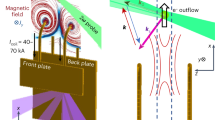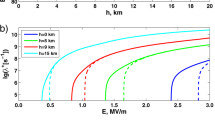Abstract
The electric discharge of a thundercloud in the troposphere is often accompanied by upper-atmospheric electric discharges such as sprites1,2 or halos3. Present models assume that the net change in the density of free electrons during these discharges is determined by the competition between electron impact ionization and electron dissociative attachment to oxygen molecules4,5,6,7, and that balance is achieved in an electric field termed the conventional breakdown field. According to these models, free electrons are removed in an electric field whose strength is below the breakdown field, but multiply in a field that is stronger than the breakdown field. Here we use a simple model of the electric response of the mesosphere at timescales of tens of milliseconds to show that in the upper atmosphere, electrons multiply also under field strengths significantly below that of the conventional breakdown field because, at low pressure, electron associative detachment from atomic oxygen ions8,9 counteracts the effect of dissociative attachment. Our model couples chemical kinetics to dielectric relaxation, and our simulations indicate that associative detachment could explain recent measurements of the time and altitude of the inception of delayed sprites10. We conclude that associative detachment is a fundamental process in upper-atmospheric electrodynamics.
This is a preview of subscription content, access via your institution
Access options
Subscribe to this journal
Receive 12 print issues and online access
$259.00 per year
only $21.58 per issue
Buy this article
- Purchase on Springer Link
- Instant access to full article PDF
Prices may be subject to local taxes which are calculated during checkout



Similar content being viewed by others
Change history
29 November 2011
This manuscript was originally incorrectly published as an Article. It has now been changed to the correct category of a Letter in all versions.
References
Franz, R. C., Nemzek, R. J. & Winckler, J. R. Television image of a large upward electrical discharge above a thunderstorm system. Science 249, 48–51 (1990).
Sentman, D. D., Wescott, E. M., Osborne, D. L., Hampton, D. L. & Heavner, M. J. Preliminary results from the Sprites94 aircraft campaign: 1. Red sprites. Geophys. Res. Lett. 22, 1205–1208 (1995).
Barrington-Leigh, C. P., Inan, U. S. & Stanley, M. Identification of sprites and elves with intensified video and broadband array photometry. J. Geophys. Res. 106, 1741–1750 (2001).
Pasko, V. P. Recent advances in theory of transient luminous events. J. Geophys. Res. 115, A00E35 (2010).
Liu, N. & Pasko, V. P. Effects of photoionization on propagation and branching of positive and negative streamers in sprites. J. Geophys. Res. 109, A04301 (2004).
Luque, A. & Ebert, U. Emergence of sprite streamers from screening-ionization waves in the lower ionosphere. Nature Geosci. 2, 757–760 (2009).
Hu, W., Cummer, S. A. & Lyons, W. A. Testing sprite initiation theory using lightning measurements and modeled electromagnetic fields. J. Geophys. Res. 112, D13115 (2007).
Moruzzi, J. L. & Price, D. A. Ionization, attachment and detachment in air and air–CO2 mixtures. J. Phys. D 7, 1434–1440 (1974).
Rayment, S. W. & Moruzzi, J. L. Electron detachment studies between o- ions and nitrogen. Int. J. Mass Spectrom. Ion Phys. 26, 321–326 (1978).
Gamerota, W. R. et al. Comparison of sprite initiation altitudes between observations and models. J. Geophys. Res. 116, A02317 (2011).
Wilson, C. T. R. The electric field of a thundercloud and some of its effects. Proc. Phys. Soc. Lond. 37, 32D–37D (1924).
Roussel-Dupré, R. & Gurevich, A. V. On runaway breakdown and upward propagating discharges. J. Geophys. Res. 101, 2297–2311 (1996).
Pasko, V. P., Inan, U. S., Bell, T. F. & Taranenko, Y. N. Sprites produced by quasi-electrostatic heating and ionization in the lower ionosphere. J. Geophys. Res. 102, 4529–4561 (1997).
Pasko, V. P., Inan, U. S. & Bell, T. F. Spatial structure of sprites. Geophys. Res. Lett. 25, 2123–2126 (1998).
Raizer, Y. P., Milikh, G. M., Shneider, M. N. & Novakovski, S. V. Long streamers in the upper atmosphere above thundercloud. J. Phys. D 31, 3255–3264 (1998).
Cummer, S. A. & Füllekrug, M. Unusually intense continuing current in lightning produces delayed mesospheric breakdown. Geophys. Res. Lett. 28, 495–498 (2001).
Raizer, Yu. P. Gas Discharge Physics (Springer, 1991).
Rakov, V. A. & Uman, M. A. Lightning (Cambridge Univ. Press, 2003).
Fridman, A. A. & Kennedy, L. A. Plasma Physics and Engineering (Taylor and Francis, 2004).
Gordillo-Vázquez, F. J. Air plasma kinetics under the influence of sprites. J. Phys. D 41, 234016 (2008).
Gordillo-Vázquez, F. J. & Luque, A. Electrical conductivity in sprite streamer channels. Geophys. Res. Lett. 37, L16809 (2010).
Hagelaar, G. J. M. & Pitchford, L. C. Solving the Boltzmann equation to obtain electron transport coefficients and rate coefficients for fluid models. Plasma Sources Sci. Technol. 14, 722–733 (2005).
Phelps, A. V. & Pitchford, L. C. Anisotropic scattering of electrons by N2 and its effect on electron transport. Phys. Rev. A 31, 2932–2949 (1985).
Bell, T. F., Reising, S. C. & Inan, U. S. Intense continuing currents following positive cloud-to-ground lightning associated with red sprites. Geophys. Res. Lett. 25, 1285–1288 (1998).
Li, J., Cummer, S. A., Lyons, W. A. & Nelson, T. E. Coordinated analysis of delayed sprites with high-speed images and remote electromagnetic fields. J. Geophys. Res. 113, D20206 (2008).
Cummer, S. A. Current moment in sprite-producing lightning. J. Atmos. Sol. Terr. Phys. 65, 499–508 (2003).
Luque, A. & Gordillo-Vázquez, F. J. Sprite beads originating from inhomogeneities in the mesospheric electron density. Geophys. Res. Lett. 38, L04808 (2011).
Morrill, J. et al. Electron energy and electric field estimates in sprites derived from ionized and neutral N2 emissions. Geophys. Res. Lett. 29, 1462 (2002).
Luque, A. & Ebert, U. Sprites in varying air density: Charge conservation, glowing negative trails and changing velocity. Geophys. Res. Lett. 37, L06806 (2010).
Williams, E. R. Problems in lightning physics—the role of polarity asymmetry. Plasma Sources Sci. Technol. 15, S91–S108 (2006).
Acknowledgements
This work was supported by the Spanish Ministry of Science and Innovation, MICINN under project AYA2009-14027-C05-02 and by the Junta de Andalucía, Proyecto de Excelencia FQM-5965.
Author information
Authors and Affiliations
Contributions
F.J.G-V. first included the associative detachment reaction in his kinetic model (ref. 20) and pointed to its relevance in preliminary kinetic simulations in the context of this work. A.L. developed the self-consistent model detailed here and proposed the connection with delayed sprite inception. Evaluation, interpretation and literature studies were carried out together.
Corresponding author
Ethics declarations
Competing interests
The authors declare no competing financial interests.
Supplementary information
Supplementary Information
Supplementary Information (PDF 4601 kb)
Rights and permissions
About this article
Cite this article
Luque, A., Gordillo-Vázquez, F. Mesospheric electric breakdown and delayed sprite ignition caused by electron detachment. Nature Geosci 5, 22–25 (2012). https://doi.org/10.1038/ngeo1314
Received:
Accepted:
Published:
Issue Date:
DOI: https://doi.org/10.1038/ngeo1314
This article is cited by
-
Spectroscopy of a mesospheric ghost reveals iron emissions
Nature Communications (2023)
-
Problems of Lightning Initiation and Development
Radiophysics and Quantum Electronics (2022)
-
Lower ionospheric electron density changes following lightning discharges
Acta Geophysica (2018)
-
Self-Consistent Model of a Night Sprite
Radiophysics and Quantum Electronics (2017)
-
Atmospheric Electrification in Dusty, Reactive Gases in the Solar System and Beyond
Surveys in Geophysics (2016)



